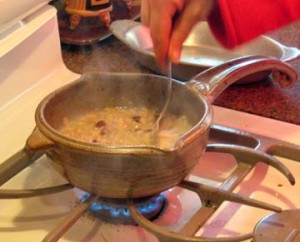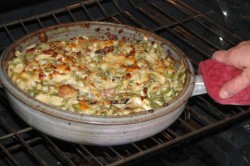Cooking in clay pots results in better tasting food.
But traditionally, stoneware pots could only be used in the oven. When Paula Wolfert started working on her book “Mediterranean Clay Pot Cooking” she was looking for a US potter to make stoneware that would also go on a direct flame stovetop. She put us in touch with Bill Sax who was extremely generous with his knowledge and experience with this type of ware.
We’ve worked well over 2 years now developing, perfecting and testing a stoneware based, ceramic stovetop cookware that will take a direct flame. (As of this edit, Dec. 2014 we’ve been selling flameware on our main website www.claycoyote.com for about 6 years). Doing this, we’ve learned a lot about how to best use this somewhat new type of skillets, pans, casseroles and specialty cookware.
It’s fairly well established, if not scientifically, that food tastes better when cooked in clay. Actually, way back when, the concept of cooking foods and combining ingredients, was essentially made possible by the discovery of clay as a material from which to make cookware.
Today there is a lot of cookware available made from lower fired earthenware based pottery. Some of it is capable of use on a stovetop. Much of this is imported to the US from Mediterranean countries, Japan, Mexico and China.
What I’m talking about in this post is a relatively new (25 or so years) type of clay similar to stoneware, but formulated to withstand the thermal shock of use on a direct flame without any flame spreader or other protection. So here we go:
 The biggest single thing that makes flameware different is that it is an insulator compared to any other cooking utensils. Glass is the only thing close. This insulating attribute is what separates it from other cookware and what requires some different handling and procedures.
The biggest single thing that makes flameware different is that it is an insulator compared to any other cooking utensils. Glass is the only thing close. This insulating attribute is what separates it from other cookware and what requires some different handling and procedures.
WHEN HEAT IS PUT IN…It goes all the way through. With a metal pan, you typically turn the flame up to get the pan hot, then turn it down for cooking. The pan loses heat almost immediately. With flameware, you go directly to the cooking temperature. If you turn the flame high to start with, that heat will go through the pot and probably burn the food.
TURN HEAT DOWN OR OFF EARLY…the heat capacity of ceramic pots means they hold heat for several minutes. If you need to reduce heat, do so a couple of minutes early. If you are turning the heat off, do so before the dish is done, or remove it from the pan.
HANDLES WON’T GET HOT…unless you put flame directly on them or put the pot in the oven.
NO NEED TO PRE-TREAT or SEASON FLAMEWARE POTS…With most earthenware pots (especially unglazed) pre-treatment is needed, either to prepare for cooking (typically soaking) or before cooking (seasoning). A little oil for cooking is all that’s needed.
FLAMEWARE WORKS ON ALL TYPES OF STOVES…gas, conventional electric burner, glass top (both coil and halogen) and all ovens. To use it on an induction stove, you will need a metal induction heat source. You will NOT need a flame spreader or diffuser on any of these although you certainly can use one.
The reason for using a diffuser is that, being an insulator, the heat comes through the flameware in a more localized pattern and can, if the food isn’t stirred regularly, burn the dish.
CLEAN UP IS EASY…soak in water for a while and most food will scrub away. It’s not quite non-stick, but it is easy clean. If you burn something on, we’ve found the easiest clean-up is a spray with E-Z Off oven cleaner, let it sit a half hour and wipe clean. You can use any green scrubby, Brillo pad or scouring pad. Dishwasher cleaning is fine.
GO FROM STOVE TO OVEN TO TABLE…no need to dirty an extra pan to  combine sautéed ingredients with sauces, vegetables and meats. Do it all in one! Sauté first, add other ingredients, liquids and cover and cook on the stovetop (ala a tagine) or slip into the oven to finish cooking.
combine sautéed ingredients with sauces, vegetables and meats. Do it all in one! Sauté first, add other ingredients, liquids and cover and cook on the stovetop (ala a tagine) or slip into the oven to finish cooking.
Once you get used to cooking with flameware, you’ll find yourself reaching for it more and more.
